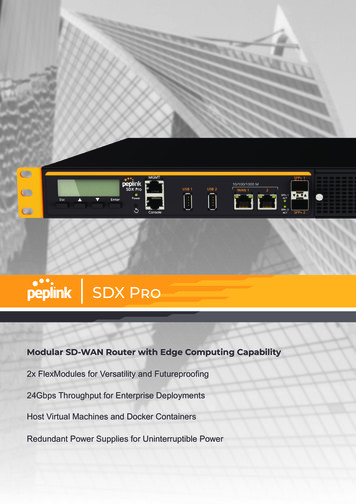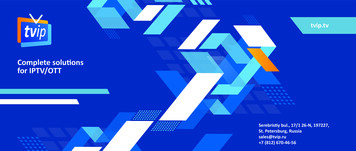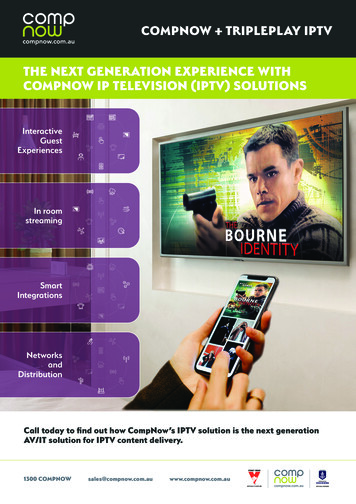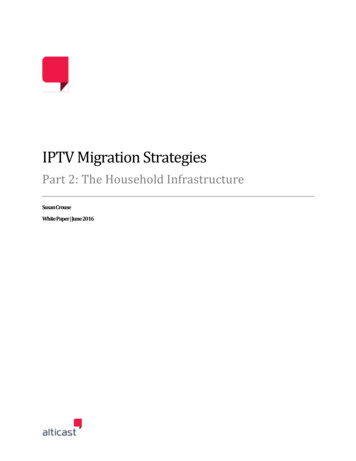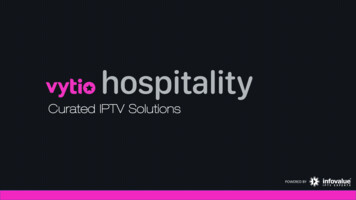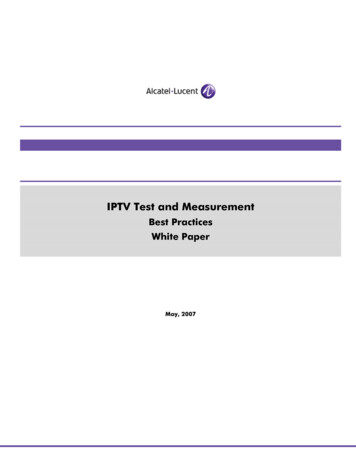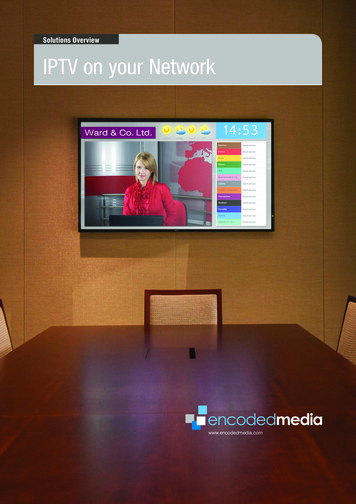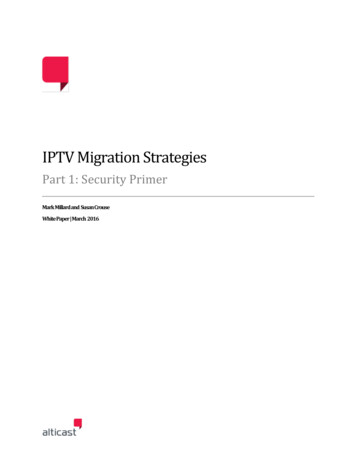
Transcription
lardandSusanCrouseWhitePaper March2016
ContentsExecutive Summary3The Challenges of Moving to All-IPTV4End-to-End Ecosystem SecurityIP Security ConsiderationsSecuring the DeviceSecuring the Network and CustomersSecuring the Cloud778910End-to-End Security Testing12Conclusion12References13Contact Alticast14AlticastConfidential 2016
ExecutiveSummaryCable Operators have built up sophisticated systems for delivering mediaservices to the home. They have been through complex infrastructuretransitions in the past -- for example, moving from analog to digital to HD.Now many are considering or have even begun their next revolution formedia delivery, the transition to an all-IP or hybrid IPTV infrastructure. the newbehaviors ofmillenials forconsuming videoon their owndevices, createsa challenge forMSOs toconsider howthey canrepositionthemselves asinnovatorsThe motivations for this change are multi-faceted. Some operators arenegotiating content rights that would broaden their footprint to allow themto deliver content in a true TV Everywhere model. This also may allowsome to deliver content in both a managed and unmanaged networkincluding out-of-geography content delivery. This provides the opportunityto engage a larger viewer base and increase revenue through devicesupport models while delivering to a multitude of both MSO devices andconsumer devices. With the new FCC NPRM opening retail markets forSTBs, there is more impetus to consider new delivery systems to supportthe possible influx of retail STBs offered directly to consumers, whilecontinuing to add value to the operator’s leased box offerings.In addition, moving to IPTV delivery may increase the demand for fasterbroadband services, so this could alone drive revenue on the broadbandservices side of the MSO business.Another motivation is to design an infrastructure that allows for servicesexpansion. This might be through Internet of Things HouseholdAutomation, or it could be by providing other applications to users,whether via additional Video Solution partners or via applications from theMSO that enhance the media or home automation experience.With Amazon, Google, Roku and Apple already providing IPTV mediasolutions, MSOs may see these as challenges to change their ownmethods. There is an innovation perception particularly by cord-nevers,that devices like HDMI dongles and small footprint pucks that delivervideo “over the top” are new and better technology. As well, cord-neversare less willing to lease HW for video consumption. This perception andthe new behaviors of millenials for consuming video on their own devicescreate a challenge for MSOs to consider how they can repositionthemselves as innovators. Part of the challenge is content packaging. Thecord-nevers also trend towards OTT services because they can buyspecific content offerings. MSOs are beginning to address this byunbundling their content and allowing users to design their own contentpackages. This ability is often based on renegotiating contracts with theirAlticast 20163
content providers and adding new content by partnering with new mediaservices.To enable this new business opportunity and take advantage of businessexpansion, operators need to consider developing an IPTV ecosystem.Building an IPTV delivery system is a complex undertaking. There aremany things to consider when creating a viable, reliable, robustarchitecture. This also provides an opportunity for operators to innovate inthe overall solution not only for the architecture, but for service, supportand business rules. While developing this new solution, operators canconsider how to save costs with the dynamic nature of a cloudarchitecture for growth and redundancy, as well as premises installation,services and monitoring and maintenance of both operator and userdevices.TheChallengesofMovingtoAll- ‐IPTVWhen considering development of an IPTV delivery solution, thesystem needs a fresh approach filled with opportunity for cost savings,delivery optimization and innovative solutions for the subscribers. Thisextensive list of questions below covers issues that should beaddressed: What legacy infrastructure is still meaningful?MoCA, QAM, Switched Digital Video, DTA, CAS, DRM,Transcoding, DOCSIS. What new infrastructure and operational processes are desired?Private/Public cloud infrastructure, content ingest andmanagement, content transcoding, content deliverynetwork, DOCSIS, DRM, centralized vs. distributedoperations (some change, some remain same),billing/payment/packaging options (millennials leading wayfor no long term contracts, etc ), integration with “BigData” systems for operations and revenue-generatingservices such as advertising.Alticast 2016 How is DOCSIS 3.1 optimally used in an IPTV delivery system? What does the household ecosystem look like?4
o Gateway, user devices, STBs/dongles, wireless vs. wired,the mixture of in-home (e.g., multi-room DVR) vs cloudbased services.What formats do we need to support to deliver the media (both forstoring and streaming)?oHLS, V9, MPEG-DASH, RTMP, RTSP, etc.oH.264, HEVC, etc. What are the pros and cons of Adaptive Bit Rate Streaming (ABR)? What will be the proper mixture of multicast vs unicast services? How are UI and video streaming guaranteed as consumersupdate software on devices and acquire new devices?(What is the best way to deliver multiple UIs for the varietyof devices that need to be supported?)Alticast 2016 How is quality of service (QoS) ensured for video delivery in andout of the home? Will there be new methods for in-home Broadband Networkmanagement? How is integration designed for other services like sVOD, cDVR,dvertising ? What does the high level architecture look like, including DVR andAdvertising? Should Internet-like payment systems, for example PayPal forshopping applications, be considered for integration? (“one-clickpurchases”) How is content protected to all devices in and outside of the home?How are multiple types of encryption (multi-DRM) handled? Do we need to use multi-cast to maximize video deliveryefficiencies? What about 4K? Are there new analytics that should be monitored and managedand how is that done? What are the support challenges?5
What opportunities exist for simplification of our current system? Is this a good time to consider different approaches to billing,backoffice SW, transcoding, storage and other systemcomponents? How much will this cost and how long will it take? What should be considered when selecting anApplication/Services ecosystem: oWhose apps? Any apps? Whether allied with a particularapplication ecosystem like Google, or with a privateecosystem?oIndustry solutions (e,g., RDK) vs. global marketplacesolutions (e.g., Android).oNeed for services outside of the operator to addfunctionality (i.e., Google managed services) or providingaccess to services (i.e., IoT collection and backhaul).oSecurity, operations vs. development – Selecting aframework for development and more importantlydeployment and operations, as well as securing customerinformation within the box, the network and the cloud.With all these issues and questions, the examination of an IPTVsystem can be broken down into a few key categories.Video Delivery Architecture: HeadEnd to the Last MileBusinesss InfrastructureDevice EcosystemE2E Ecosystem SecurityService and SupportFuture Proofing the Solution (4K VR IoT)To cover the plethora of issues, IPTV Migration will be broken down into aseries of papers. This first part covers E2E security for IP services.Alticast 20166
With theincreasingnumber of appsused for personaldata, such ashealth monitoringand homemonitoring,overall security iscoming to theforefront of anynew STBconversation.End- ‐to- ond content protection, there are a number of security requirementsfor an IPTV delivery system. These include account protection, user dataprotection, application data protection, potentially a ‘household firewall’ forIoT operations and more. With the increasing number of apps used forpersonal data, such as health monitoring and home monitoring, overallsecurity is coming to the forefront of any new STB conversation. Somenew apps coming to STBs include pairing or operation from consumermobile and tablet devices. Those connections usually are bound overwireless networks using various communication protocols, for exampleWiFI, Bluetooth and LTE.When developing this new infrastructure can bring an abundance ofopportunities beyond video consumption, all areas of security should beconsidered. The operator can consider addressing security holistically forthe home using a variety of services and as a pathway of those servicesto cloud operations, including asset and data storage.Operators need to consider end-to-end security solutions that address thefollowing scenarios:§ Account protection and access to users’ credentials.§ User data protection such as access to users’ profile meta dataand billing details. Operators should protect their subscribersagainst fraud, malware, spyware, hacker attacks and identity theft.§ Application data stored both locally on the CPE as well asmanaged in the cloud.§ Securing a range of devices that may or may not be managed bythe operator.§ Zero day attacks where hackers exploit security holes before theoperator or device vendor becomes aware of them.§ Threats to operator managed devices (i.e. gateways) that includeshutting down or bricking a device (including Blackmail).§ WiFi security from gateways to CPE on the home network (LAN).End-to-end security solutions should provide the operator with thefollowing benefits:Alticast 20167
§ Minimize operator liability through threat detection and mitigationin a timely fashion.§ Enable collection, monitoring and storage of security data suchthat operational requirements (DevOps) are less demanding onoperator resources.§ Introduce security analytics, providing expertise that may notreside in-house.§ Allow active controls and tools that facilitate dynamic end-to-endmanaged service and device management.§ Increase levels of quality of service (QoS) protection and businesscontinuity (minimize disrupted services).§ Enable operator confidence on device behavior and reaction tothreats in a deterministic and predictable manner.With these considerations in mind, there are three broad categories ofsecurity that should be addressed in the IP ecosystem: securing thedevice, securing the network, and securing the cloud.SecuringtheDeviceOperators must ensure that the IP set-top and gateway devices placed onthe customer’s premises don’t threaten their network infrastructure or thecustomer’s home network. For devices managed by the operator, thesoftware stack employed by the OEM vendor (i.e. OS, middleware,application utilities) must be hardened against known avenues of attackand threats. Likewise, software distributed by the operator (i.e. UX/UIapplications and services) must face the same level of security as thestack. If third-party applications are available to the operator’s manageddevice, then the operator must vet the application for security risks priorto deployment.Technological approaches towards hardening the OEM and operatorsoftware against security threats include:Alticast 2016§ Hardware Root of Trust§ § § § § Secure Boot Loader§ Address ObfuscationRole-based Access Control (RBAC)Buffer Overflow ProtectionReturn Into libc Attack ProtectionSecure Program Execution8
§ § § § § § Code Injection Attack Protection§ Secure Dynamic Module Loading (Kernel and User)SELinuxApplication SandboxingDetection and Prevention of Memory Corruption AttacksTLB-miss Corruption BlockingProcess Footprint WipingThese topics are beyond the scope of this overview. However, theyintroduce the complexity of the solution required to safeguard theoperator’s device and client applications.SecuringtheNetworkandCustomersNetwork security is already of principal concern to operators havingdeployed millions of set-top boxes and gateway devices for QAM- andDOCSIS-based platforms. Moving to an IP ecosystem will not minimizethis challenge. The operator must adopt policies and technologies toprevent and monitor unauthorized access, misuse and modifcation oftheir services. This includes threats that leverage techniques for denyingcustomers access to a computer network (WAN or LAN) and networkaccessible resources such as the Internet or operator specific services.Network adminstration and DevOps control the authorization of access todata on a operator’s network. Tools must be put in place to monitordevice and back office server activity and enforce the access controlpolicies for these network components. Even if the attacker obtains rootaccess, they should not be able to change the policy, therefore disablingthe security mechanisms in place.As threats are detected and identified, the operator must be able todynamically respond and control security settings and policies from theheadend. Both client and server components in the IP ecosystem need toprovide ways to actively modify these security policy changes in real tme.The operator must protect against both passive and active attacks on thenetwork. Passive attacks occur when a network intruder intercepts datatraveling through the network between the IP ecosystem/headend serversand the CPE. Active attacks occur in which an intruder initiatescommands and software to disrupt the network's normal operation1.1See reference to Computer and Information Security Handlbook below.Alticast 20169
Passive attacks include:§ § Wiretaps§ Idle scansPort scannersActive attacks include:§ Denial-of-service attacks§ DNS spoofing§ Man in the middle attacks§ ARP poisoning§ § VLAN hopping§ § Buffer overflows§ § Format string attacks§ § Phishing§ § Cross-site Request Forgeries (CSRF)Smurf attacksHeap overflowsSQL injectionsCross-site scriptingCyber-attacksAgain these topics are beyond the scope of this overview. However,operator’s must become aware of these threats in order to instrumentpolicies and solutions to protect their customers and brand reputation.SecuringtheCloudAdditional threats are introduced by the IP ecosystem employed to deliverthe operator cloud-based services. As more services are implemented inthe cloud outside the controlled operator environment, the potential fordata to be compromised increases. The cloud service may or may not bemanaged directly by the operator; for example, when it is a CDN or thirdparty media service. The failure to address security threats with the cloudservice provider will put the data’s availability and integrity at risk.Software as a Service (SaaS) and/or Platform as a Service (PaaS) haveunique security challenges. In SaaS environments the cloud serviceAlticast 201610
provider is responsible for security controls that target the applicationspace such as the content delivery, billing management system, andcustomer account management. In PaaS solutions, the cloud serviceprovider and operator are both responsible for addressing security threatssince the application is most likely a custom solution implemented andmanaged by the operator. Note that the security issues are the sameregardless of whether the deployment model is a private, public or hybridcloud infrastructure.One way to mitigate security threats in the cloud is to adopt securitystandards when determining an operator’s security policy. Standards arebased on different approaches for security, system development, financialreporting, IT service delivery, or control environments. ISO, theInternational Standards Organization, publishes an audit standard forInformation Security Management Systems (ISO/IEC 27001). NIST, theNational Institute of Standards and Technology, publishes papers relatedto information security that may be useful for determining policy. Also, theUnited States Federal Government has created standards forcategorizing information and systems that offer minimum securitysolutions (FIBS Pub 200). A cloud service provider may offer certificationin ISO, NIST or FISMA standards; this certification should be consideredby the operator while investigating cloud-based solutions.In addition to standards, an operator must consider the following:§ Assessing risk based on available resources for monitoring andmanaging their network and data.§ Reviewing traditional security mechanisms already in place suchas firewalls, Intrusion Detection Systems (IDS), IntrusionPrevention Systems (IPS) or Network Access Control (NAC)products.§ Adopting new tools and processes that target virtualizationsolutions as opposed to legacy utilities that only work well forservices located on physical premises under the operator’s control.Alticast 201611
End- ‐to- ‐EndSecurityTestingAs a system is designed and developed, a test plan needs to be createdthat focuses on the operator’s security policy. Implementing a securitypolicy can be one of the more difficult tasks. It is challenging to ensurethat all possible attacks on a system are vetted. As well, there are oftenstandards that must be met, either published standards or specificrequirements by constituents like content owners. In addition todeveloping and executing an internal test plan, an operator may considerusing an outside consulting expert in cyber attacks to attempt to breakinto the services.Approaches to testing for secure systems is a broad and specialized topic.Much of this is addressed directly for content through approved methods– in particular when hardware like cable cards are part of the system. Themove away from cable cards in IPTV creates a different testingenvironment. Test plans should be integral parts of the complete systemdesign.ConclusionSecurity for IPTV is a broad issue, as apparent from both the areas thatneed protection, standards to be met, the various ways infrastructurescan be attacked and the testing necessary to ensure success. Whendeveloping an IPTV delivery solution it is paramount to make security atop priority in system design.Early on, operators primarily addressed content security as mandated bythe content owners. With the fast growth in broadband services,combined with media content protection, security demands for data overbroadband become even more critical. As IPTV becomes prominent fordelivering media, even more information is traveling on these networks.With 4K emerging as the next video format, content security requirementsfrom content owners are evolving to be more robust. The variations ofnetworks, systems and data are putting security at the forefront ofoperator service requirements as they need to be vigilant about bothmedia and data protection for their subscribers. Designing security intothe architecture up front is important to ensure all the bases are covered.Alticast 201612
ReferencesAndroidauthority.com Rob Triggs Dec. 2014Wright, Joe; Jim Harmening (2009) "15" Computer and InformationSecurity Handbook Morgan Kaufmann Publications Elsevier Inc p. 257Wikipedia contributors. "Network security." Wikipedia, The FreeEncyclopedia. Wikipedia, The Free Encyclopedia, 18 Mar. 2016. Web. 19Mar. 2016.Cloud Security Alliance, https://cloudsecurityalliance.orgAlticast 201613
aTel SATel erdam,NetherlandsTel 31(0)202403190eu@alticast.comThis document is protected by copyright and distributed under licenses restricting its use, copying, and distribution.No part of this document may be reproduced in any form by any means without the express written permission ofAlticast Corporation.All trademarks and registered trademarks are the property of their respective owners in the United States and/orother countries.Android is a trademark of Google Inc.All Roku trademarks are the exclusive property of Roku. 2016 Alticast Corporation. All rights reserved.Alticast 201614
To enable this new business opportunity and take advantage of business expansion, operators need to consider developing an IPTV ecosystem. Building an IPTV delivery system is a complex undertaking. There are many things to consider when creating a viable, reliable, robust architecture. This also provides an opportunity for operators to innovate in

